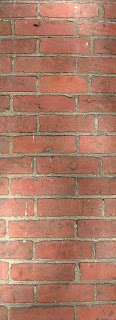
I've been thinking hard about just what it is that I find attractive about Richmond's brick houses. Because it's specifically the brick ones that reach out and grab my heart and make me love them. I like some of the gingerbread on a nice big wood frame Victorian, but it doesn't really get me in the same way.
And you know, I don't care about modern brick structures either - bank buildings or what have you. It's slowly dawned on me that there's something about the 19th-century brick houses here quite specifically. And it's not just architecture, either. There are little single-story boxes built in the 19th century that I look at, walking past, and think, oh, how charming.
I finally figured it out.
The bricks I like were handmade.
That's it. That's the whole reason I like them - they're irregular. So I figured I'd find out how to make them. After all, I might end up marooned in the Caribbean and have to build a brick Italianate house myself, from scratch. I know it's technically possible. I just need to find out how.
So there's a
guy in Delphi, Indiana who makes bricks and blogs about it.
Colonial Williamsburg actually fires a batch of bricks every year. When it comes to laying brick, moreover, here's a
fantastic overview. Richmond masons seem to have adhered to a Liverpool bond (
correction: nope, it's an American common bond). I can take a picture of the carriage house that illustrates it if you're interested. I worked out the necessity for bonding just from observing the interior and exterior of the carriage house last month, finally struck by the epiphany that there were rows of bricks
through the wall to hold the layers together.
That same site has a nice 19th century scan about
brickmaking.
So this blog may eventually morph from restoration of a Richmond brick house to construction of a replica in Puerto Rico. There's no way to know!
Update: here's a link to a preservation document from
St. Thomas, not terribly far from Ponce. (If you take the ferry to Culeibra, which is a Puerto Rican island, you can see the Virgin Islands from it - it's often called the "Spanish Virgin Island".)
The bricks in the picture are on the south wall of the ballroom. My heart skips a beat just looking at that picture. Seriously. I'm done for in terms of loving these bricks.
